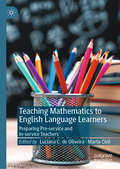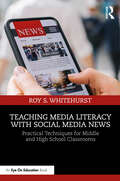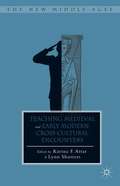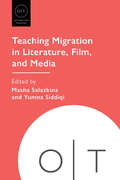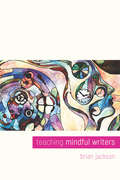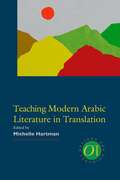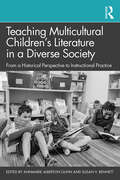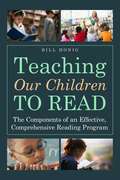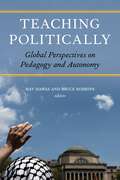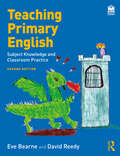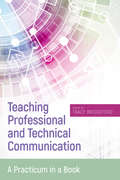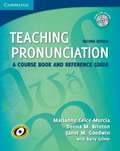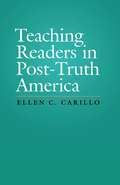- Table View
- List View
Teaching Mathematics to English Language Learners
by Denisse R. Thompson Gladis Kersaint Mariana PetkovaToday's mathematics classrooms increasingly include students for whom English is a second language. Teaching Mathematics to English Language Learners provides readers a comprehensive understanding of both the challenges that face English language learners (ELLs) and ways in which educators might address them in the secondary mathematics classroom. Framed by a research perspective, Teaching Mathematics to English Language Learners presents practical instructional strategies for engaging learners that can be incorporated as a regular part of instruction. The authors offer context-specific strategies for everything from facilitating classroom discussions with all students, to reading and interpreting math textbooks, to tackling word problems. A fully annotated list of math web and print resources completes the volume, making this a valuable reference to help mathematics teachers meet the challenges of including all learners in effective instruction. Features and updates to this new edition include: An updated and streamlined Part 1 provides an essential overview of ELL theory in a mathematics specific context. Additional practical examples of mathematics problems and exercises make turning theory into practice easy when teaching ELLs New pedagogical elements in Part 3 include tips on harnessing new technologies, discussion questions and reflection points. New coverage of the Common Core State Standards, as well as updates to the web and print resources in Part 4.
Teaching Mathematics to English Language Learners: Preparing Pre-service and In-service Teachers (English Language Education Ser. #17)
by Luciana C. de Oliveira Marta CivilThis edited book is about preparing pre-service and in-service teachers to teach secondary-level mathematics to English Language Learners (ELLs) in twenty-first century classrooms. Chapter topics are grounded in both research and practice, addressing a range of timely topics including the current state of ELL education in the secondary mathematics classroom, approaches to leveraging the talents and strengths of bilingual students in heterogeneous classrooms, best practices in teaching mathematics to multilingual students, and ways to infuse the secondary mathematics teacher preparation curriculum with ELL pedagogy. This book will appeal to all teachers of ELLs, teacher educators and researchers of language acquisition more broadly. This volume is part of a set of four edited books focused on teaching the key content areas to English language learners. The other books in the set focus on teaching History and Social Studies, English Language Arts, and Science to ELLs.
Teaching Media Literacy with Social Media News: Practical Techniques for Middle and High School Classrooms
by Roy S. WhitehurstFeaturing tools, activities, and insightful stories from a CIA analyst and instructor with 30+ years’ of experience, this practical and engaging book supports busy educators to teach the lifelong skills of news and media literacy to their students.Based on existing curriculum and teaching standards, this guidebook shows how social studies and English language arts (ELA) teachers can build students’ confidence with social media evaluation skills, which are critical to engaging in civic discourse and building a stronger democracy. In Part 1, Whitehurst gives an overview of the media evaluation techniques based on those you would learn as a CIA analyst, including understanding how our biases and mindset make us vulnerable to disinformation, learning how media tries to persuade us, checking facts, and spotting disinformation. Part 2 dives deeper by showing teachers how learners can check if an argument on social media is valid, and how fallacies and manipulation tactics in online arguments can complicate this important skill. It is illustrated by examples from social media and contemporary popular culture in different mediums, including videos, photos, memes, and AI-generated content. You can also find fresh and updated social media examples on the author’s website, News Literacy Sleuth.Packed with practical classroom resources, examples from popular culture, and engaging insights into the CIA analyst role, this book is designed to support middle and high school teachers with news and media literacy in social studies, civic education, and ELA.
Teaching Medieval And Early Modern Cross-cultural Encounters
by Karina F. Attar Lynn ShuttersDrawing from theatre, English studies, and art history, among others, these essays discuss the challenges and rewards of teaching medieval and early modern texts in the 21st-century university. Topics range from the intersections of race, religion, gender, and nation in cross-cultural encounters to the use of popular culture as pedagogical tools.
Teaching Migration in Literature, Film, and Media (Options for Teaching)
by Yumna Siddiqi Masha SalazkinaPeople migrate to seek opportunities, to unite with family, and to escape war, persecution, poverty, and environmental disasters. A phenomenon that has real, lived effects on individuals and communities, migration also carries symbolic, ideological significance. Its depiction in literature, film, and other media powerfully shapes worldviews, identities, attitudes toward migrants, and a political landscape that is both local and global. It is imperative, then, to connect the disciplinary and theoretical tools we have for understanding migration and to put them in conversation with students' experiences.Featuring a wide range of classroom approaches, this volume brings together topics that are often taught separately, including tourism, slavery, drug cartels, race, whiteness, settler colonialism, the Arab Spring, assimilation, and disability. Readers are introduced to terminology and legal frameworks and to theories of migration in relation to Black studies, ethnic studies, Asian American studies, Latinx studies, border studies, postcolonial studies, and Indigenous studies.
Teaching Mindful Writers
by Brian JacksonTeaching Mindful Writers introduces new writing teachers to a learning cycle that will help students become self-directed writers through planning, practicing, revising, and reflecting. Focusing on the art and science of instructing self-directed writers through major writing tasks, Brian Jackson helps teachers prepare students to engage purposefully in any writing task by developing the habits of mind and cognitive strategies of the mindful writer. Relying on the most recent research in writing studies and learning theory, Jackson gives new teachers practical advice about setting up writing tasks, using daily writing, leading class discussions, providing feedback, joining teaching communities, and other essential tools that should be in every writing teacher’s toolbox. Teaching Mindful Writers is a timely, fresh perspective on teaching students to be self-directed writers.
Teaching Modern Arabic Literature in Translation (Options for Teaching #42)
by Michelle HartmanUnderstanding the complexities of Arab politics, history, and culture has never been more important for North American readers. Yet even as Arabic literature is increasingly being translated into English, the modern Arabic literary tradition is still often treated as other--controversial, dangerous, difficult, esoteric, or exotic. This volume examines modern Arabic literature in context and introduces creative teaching methods that reveal the literature's richness, relevance, and power to anglophone students.Addressing the complications of translation head on, the volume interweaves such important issues such as gender, the Palestinian-Israeli conflict, and the status of Arabic literature in world literature. Essays cover writers from the recent past, like Emile Habiby and Tayeb Salih; contemporary Palestinian, Egyptian, and Syrian literatures; and the literature of the nineteenth-century Nahda.
Teaching Modern British and American Satire (Options for Teaching #45)
by Evan R. Davis and Nicholas D. NaceThis volume addresses the teaching of satire written in English over the past three hundred years. For instructors covering current satire, it suggests ways to enrich students' understanding of voice, irony, and rhetoric and to explore the questions of how to define satire and how to determine what its ultimate aims are. For instructors teaching older satire, it demonstrates ways to help students gain knowledge of historical context, medium, and audience, while addressing more specific literary questions of technique and form. Readers will discover ways to introduce students to authors such as Swift and Twain, to techniques such as parody and verbal irony, and to the difficult subject of satire's offensiveness and elitism. This volume also helps teachers of a wide variety of courses, from composition to gateway courses and surveys, think about how to use modern satire in conceiving and structuring them.
Teaching Modern Languages: Knowledge, Skills and Methods
by Michael LynchAn essential resource for trainee teachers and graduate students, this textbook presents strategies and practical advice for preparing and planning lessons in a clear, step-by-step way and demonstrates how to inspire confidence and competence in language learners. Chapters cover many important aspects of initial teacher training including skills development; modes of teaching; unit and lesson planning; assessment; remote learning; digital literacy, and student and teacher wellbeing. Packed with pedagogical value, each chapter includes clear learning objectives, concise chapter summaries, defined key terms, interactive box features, reflective questions and further reading recommendations. Supplementary resources include templates for planning and assessment, feed-forward and feedback forms, extra tasks and activities, and sample answers. By connecting theory and practice, this authoritative guide provides trainee teachers with the necessary tools to develop the knowledge, skills and methods required to become an effective modern languages teacher in a contemporary world.
Teaching Modern Latin American Poetries (Options for Teaching #48)
by Jill S. Kuhnheim Melaine NicholsonThe essays in this book, groundbreaking for its focus on teaching Latin American poetry, reflect the region's geographic and cultural heterogeneity. They address works from Mexico, Chile, Peru, Ecuador, Colombia, Cuba, Brazil, Argentina, Guatemala, Nicaragua, and Uruguay, as well as from indigenous communities found within these national distinctions, including the Kaqchikel Maya and Zapotec. The volume's essays help instructors teach poetry written from the second half of the twentieth century on, meaningfully connecting this contemporary corpus with older poetic traditions. Contributors address teaching various topics, from the silva and the long poem to Afro-descendant poetry, in ways that bring performance, digital approaches, queer theory, and translation into action. The insights offered here will demonstrate how Latin American poetry can become a part of classes in African diasporic studies, indigenous studies, history, and anthropology.
Teaching Multicultural Children’s Literature in a Diverse Society: From a Historical Perspective to Instructional Practice
by AnnMarie Alberton Gunn Susan V. BennettThis textbook is a comprehensive resource for teaching multicultural children’s literature. Providing foundational information on how and why to integrate diverse children’s literature into the classroom, this book presents a necessary historical perspective on cultural groups in the United States and context for how to teach children’s literature in a way that reflects and sustains students’ rich cultural backgrounds. The historical insights and context on diverse cultural groups at the heart of the book allow readers to deepen their understanding of why teaching about cultural diversity is necessary for effective and inclusive education. Part I offers foundational information on how to teach children’s literature in a diverse society, and Part II overviews pedagogy, resources, and guidance for teaching specific culturally and linguistically marginalized groups. Each chapter contains book recommendations, discussion questions, and additional resources for teachers. With authentic strategies and crucial background knowledge embedded in each chapter, this text is essential reading for pre-service and in-service teachers and is ideal for courses in children’s literature, literacy methods instruction, and multicultural education.
Teaching Narrative (Teaching The New English Ser.)
by Richard JacobsNarrative is everywhere and has unique powers: to enchant and inspire, to make sense of our lives and ourselves and to afford us an enriched understanding of alternative worlds and lives and of better futures – though narrative also has the potential to coerce and oppress. Narrative is at the centre at all stages of the English curriculum and has been the subject of a burgeoning critical industry. This timely volume addresses the many ways in which recent thinking has informed the teaching of narrative in university classrooms in the UK and the USA. Distinguished teachers from both countries range widely across narrative topics and genres, including the opportunities opened up by new technologies, and chapters articulate students’ own individual and collaborative experiences in the teaching/learning process. The result is a volume that explores the pleasurable challenges of working with students to help them appreciate and assess the power that narrative exerts, to become reflective critics of its inner workings as well as exponents of narrative themselves.
Teaching Our Children to Read: The Components of an Effective, Comprehensive Reading Program
by Bill HonigStudies of effective teaching practices have continued to validate the need for explicit and systematic instruction in basic reading skills, and Bill Honig uses this research to shed new light on an old problem-how to help all students become fluent readers. Teaching Our Children to Read grows out of the experiences of scores of dedicated teachers and their success in the classroom. This book explores current research from the leading experts in the field, and presents new instructional strategies that bring all students to higher levels of literacy.Highlights from Teaching Our Children to Read include: Phonics instruction and fluency Connected practice with decodable text Multisyllabic word instruction Spelling, vocabulary, and concept development Strategic reading, book discussions, and text organization Literacy benchmarks, assessment, and interventionThis is an essential resource for educators, administrators, policymakers, and parents concerned about how to successfully teach our children to read. Teaching Our Children to Read points the way to implementing the best research-based practices in adopting reading materials, training teachers, and providing the necessary school leadership.
Teaching Poetry in a Digital World: Inspiring Poetry Writing through Technology in Grades 6-12
by Stefani Boutelier Sarah J. DonovanTeaching Poetry in a Digital World supports English language arts (ELA) educators for grades 6–12 to incorporate digital literacy in their classrooms by teaching the reading and writing of poetry.In an increasingly digital age, educators must adapt to meet the changing needs and interests of their students by incorporating technology into the classroom. This book introduces its audience to the e-Poetry Framework. This framework demonstrates how poetry might present itself in a literacy-based unit with the benefit of a technology medium to share with the world. Examples include teaching zip-ode poetry, incorporating haiku with the creation of GIFs, and ethically discussing AI with nonet poems. With adaptable lesson plans and assessments, as well as educator examples, the book will inspire teachers to create intentional student-centered e-Poetry units.The book is aligned with ELA literacy standards, International Society for Technology in Education (ISTE) educator standards, and National Council of Teachers of English (NCTE)’s position statement for integrating technology into ELA classrooms. It is a key resource for secondary school educators teaching ELA, creative writing, and digital media.
Teaching Politically: Global Perspectives on Pedagogy and Autonomy
by May Hawas and Bruce RobbinsCulture is inextricable from politics. This includes the politics of who we are, as teachers, intellectuals, writers, cultural workers, and students, and what we want to bring to and take from the site of instruction. It also includes the politics of who we want to be, as citizens, professionals, and active contributors to our communities and to the world in general, and what we can be, realistically, in the particular contexts in which we live. Teaching Politically addresses some of the political constraints that shape our pedagogical spaces, especially in the teaching of literature. The book brings together a global group of academics, activists, public intellectuals, poets, and novelists to examine the way politics manifest pedagogically, and how a commitment to educating manifests politically, in and beyond the classroom. At the heart of the discussion is how political and professional paradigms chafe against, intersect with, or otherwise become inseparable from each other in any vocation that attempts to educate: from writing, journalism, and public speaking to art, activism, and medicine.Contributors: Dimitris Christopoulos, Dimitri Dimoulis, Khaled Fahmy, Rishi Goyal, May Hawas, Bonnie Honig, Mona Kareem, Benjamin Mangrum, Nora Parr, Bruce Robbins, Ahdaf Soueif, Omid Tofighian, Elahe Zivardar
Teaching Postcolonial Environmental Literature and Media (Options for Teaching #56)
by Cajetan IhekaTaking up the idea that teaching is a political act, this collection of essays reflects on recent trends in ecocriticism and the implications for pedagogy. Focusing on a diverse set of literature and media, the book also provides background on historical and theoretical issues that animate the field of postcolonial ecocriticism. The scope is broad, encompassing not only the Global South but also parts of the Global North that have been subject to environmental degradation as a result of colonial practices. Considering both the climate crisis and the crisis in the humanities, the volume navigates theoretical resources, contextual scaffolding, classroom activities, assessment, and pedagogical possibilities and challenges. Essays are grounded in environmental justice and the project to decolonize the classroom, addressing works from Africa, New Zealand, Asia, and Latin America and issues such as queer ecofeminism, disability, Latinx literary production, animal studies, interdisciplinarity, and working with environmental justice organizations.
Teaching Postwar Japanese Fiction (Options for Teaching #60)
by Alex BatesAs Japan moved from the devastation of 1945 to the economic security that survived even the boom and bust of the 1980s and 1990s, its literature came to embrace new subjects and styles and to reflect on the nation's changing relationship to other Asian countries and to the West. This volume will help instructors introduce students to novels, short stories, and manga that confront postwar Japanese experiences, including the suffering caused by the atomic bombings of Hiroshima and Nagasaki, the echoes of Japan's colonialism and imperialism, new ways of thinking about Japanese identity and about minorities such as the zainichi Koreans, changes in family structures, and environmental disasters. Essays provide context for understanding the particularity of postwar Japanese literature, its place in world literature, and its connections to the Japanese past.
Teaching Primary English in Australia: Subject Knowledge and Classroom Practice
by Eve Bearne David Reedy Paul Gardner Yvonne SawersThis first Australian edition of Teaching Primary English has been updated and adapted to reflect the Australian sociocultural and educational context. This text provides a comprehensive, evidence informed introduction to teaching and learning English in the primary school classroom. New content refers to the Australian English Curriculum and incorporates Aboriginal and Torres Strait Islander perspectives and literacy perspectives relevant to the Asia-Pacific region as well as the broader international context. This edition also includes a new section devoted to visual literacy, critical literacy and multimodality. Teaching advice and ideas are supported by practical examples linked to video clips filmed in real schools, reflective activities, observational tasks and online resources. Each section includes suggestions for great children’s literature and offers assessment advice and support for planning for diversity and special educational needs. Drawing on the very latest research and theory, supported by practical examples and guidance, this is an essential resource for pre-service teachers as they develop subject knowledge and the skills and confidence to deliver effective and engaging classroom practice.
Teaching Primary English through Drama: A practical and creative Approach
by Suzi Clipson-Boyles"The text is extraordinarily succinct, very well organised and highly readable. Each chapter examines in depth specific aspects of teaching and learning in drama and well-chosen practical examples can readily be adopted by teachers. A 'must' for all primary schools." Drama (the Journal of National Drama) Review of ‘Drama in Primary English teaching’ Teaching Primary English through Drama builds on the success of the classic text Drama in Primary English, inspiring ideas and techniques for teaching English skills through the medium of drama. Focusing on the power of drama to promote effective learning in primary education, Suzi Clipson-Boyles demonstrates how reading, writing, speaking and listening skills may be developed in ways that will motivate and engage pupils. She uses specific examples from the English curriculum, and also makes links to other areas of the curriculum. In addition, the book explains how assessment during drama can help teachers to evaluate pupils’ progress in English. Further guidance is given on how drama can enrich studying for pupils who are learning English as a foreign language. The book also provides a chapter on developing drama as an art form in its own right, with simple ideas and practical suggestions on how to enhance performances. Teaching Primary English through Drama presents a wide range of drama approaches from ten-minute starter activities to stimulate ideas such as fun ways to practise reading, through to longer projects that can provide contexts for extended writing or help with presentation and performance. The chapters show how drama can help to bring lessons alive in imaginative ways that not only promote enjoyment but also enhance achievement. This comprehensive and practical guide offers essential reading for primary teachers and other practitioners, and is a valuable resource to trainees. It also provides an excellent foundation for those who wish to extend their expertise further towards drama as a subject specialism.
Teaching Primary English: Subject Knowledge and Classroom Practice
by Eve Bearne David ReedyNow in its second edition, Teaching Primary English is a bestselling, comprehensive, evidence-informed guide designed to support and inspire teaching and learning in the primary school. Written in a clear and accessible way, it draws on the very latest research and theory to describe and exemplify a full and rich English curriculum. It offers those on teacher training courses, as well as qualified teachers who are looking to develop their practice, invaluable subject knowledge and guidance for effective, enjoyable classroom practice. Throughout there is an emphasis on equity and inclusion. Advice and ideas are supported by explicit examples of good teaching linked to video clips filmed in real schools, reflective activities, observational tasks and online resources. Each chapter includes suggestions for great children’s literature, considers assessment throughout and offers support in planning for inclusion and special educational needs. New and expanded areas for this edition include: Multimodal texts Increased coverage of Early Years Dialogic learning and oracy Comprehensive companion website with revised and additional resources A new section on digital literacies Reading for pleasure Teaching grammar in context Critical literacy With a focus on connecting all modes of English, the global and the local, and home and school experience, this detailed, uplifting book, includes inspiring case studies throughout and will support you in developing a curious, critical approach to teaching and learning English. Additional content can be found on the fantastic supporting website. Features include: Video clips from within the classroom to demonstrate English teaching techniques Audio resources, including an interactive quiz, to check understanding and provide real-life examples and case studies Downloadable resources to support teaching and incorporate into lesson plans.
Teaching Professional and Technical Communication: A Practicum in a Book
by Dan Jones Traci Nathans-Kelly Christine G. Nicometo Pam Estes Brewer Kirk St. Amant Karla Saari Kitalong Dave Clark Eva Brumberger Paul Dombrowski James M. Dubinsky Peter S. England David K. Farkas Brent Henze Tharon W. HowardTeaching Professional and Technical Communication guides new instructors in teaching professional and technical communication (PTC). The essays in this volume provide theoretical and applied discussions about the teaching of this diverse subject, including relevant pedagogical approaches, how to apply practical aspects of PTC theory, and how to design assignments. This practicum features chapters by prominent PTC scholars and teachers on rhetoric, style, ethics, design, usability, genre, and other central concerns of PTC programs. Each chapter includes a scenario or personal narrative of teaching a particular topic, provides a theoretical basis for interpreting the narrative, illustrates the practical aspects of the approach, describes relevant assignments, and presents a list of questions to prompt pedagogical discussions. Teaching Professional and Technical Communication is not a compendium of best practices but instead offers a practical collection of rich, detailed narratives that show inexperienced PTC instructors how to work most effectively in the classroom. Contributors: Pam Estes Brewer, Eva Brumberger, Dave Clark, Paul Dombrowski, James M. Dubinsky, Peter S. England, David K. Farkas, Brent Henze, Tharon W. Howard, Dan Jones, Karla Saari Kitalong, Traci Nathans-Kelly, Christine G. Nicometo, Kirk St.Amant
Teaching Proficiency Through Reading and Storytelling: An Input-Based Approach to Second Language Instruction (The Routledge E-Modules on Contemporary Language Teaching)
by Karen LichtmanThis module introduces Teaching Proficiency through Reading and Storytelling (TPRS), an input-based language teaching method. TPRS provides a framework for teaching classes completely in the target language—even those at the beginner level. Through the steps of establishing meaning, creating a story that is acted out live in class, and reading, students understand and use the target language to communicate right away. Research shows that over time TPRS creates fluent speakers who excel both on traditional tests and—more importantly—in real-life situations. This is a valuable resource on TPRS for world language teachers, language teacher educators, and second language researchers.
Teaching Pronunciation: A Course Book and Reference Guide
by Donna M. Brinton Marianne Celce-Murcia Janet M. Goodwin Barry D. GrinerThe second edition includes updates and insights on current research and pedagogical practice that have developed over the last decade. This new edition of Teaching Pronunciation - undoubtedly the gold standard for pronunciation methodology texts - has been revised to reflect recent research into the sound system of North American English, as well as new practices in pronunciation pedagogy.
Teaching Publishing and Editorial Practice: The Transition from University to Industry (Elements in Publishing and Book Culture)
by Jocelyn HargraveA key challenge facing all educators working in practice-based subjects is the need to negotiate tensions between past and present and provide a training that prepares students for fast-changing conditions, while also conveying long-standing principles. This Element therefore investigates how effectively editing and publishing programmes prepare graduates for industry and how well these graduates translate this instruction to the workplace. Taking a global perspective to gauge the state of the discipline, the mixed-methods approach used for this Element comprised two online surveys for educators and graduates, three semi-structured interviews with industry practitioners (scholarly, education and trade) and ethnographic practice (author as educator and practitioner). Three key concepts also framed this Element's enquiry: being, learning and doing. The Element demonstrates how these transitioning but interdependent concepts have the potential to form a holistic practice-led pedagogy for students of editing and publishing programmes.
Teaching Readers in Post-Truth America
by Ellen C. CarilloTeaching Readers in Post-Truth America shows how postsecondary teachers can engage with the phenomenon of “post-truth.” Drawing on research from the fields of educational and cognitive psychology, human development, philosophy, and education, Ellen C. Carillo demonstrates that teaching critical reading is a strategic and targeted response to the current climate. Readers in this post-truth culture are under unprecedented pressure to interpret an overwhelming quantity of texts in many forms, including speeches, news articles, position papers, and social media posts. In response, Carillo describes pedagogical interventions designed to help students become more metacognitive about their own reading and, in turn, better equipped to respond to texts in a post-truth culture. Teaching Readers in Post-Truth America is an invaluable source of support for writing instructors striving to prepare their students to resist post-truth rhetoric and participate in an information-rich, divisive democratic society.

